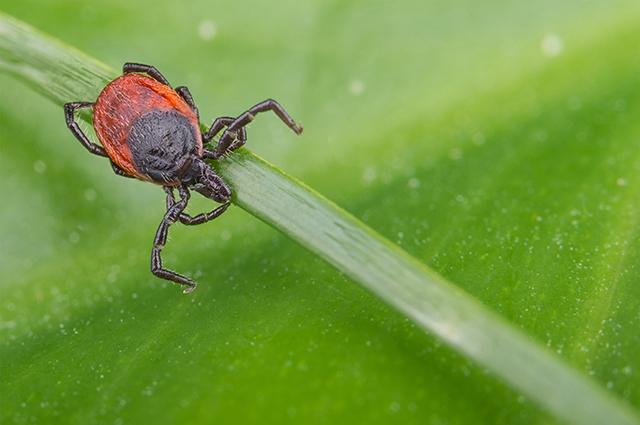-
About
- Departments & Offices
-
Academics
- Physician Assistant
- Special Master’s (MBS)
-
Admissions & Financial Aid
- Tuition & Fees
-
Student Life
-
- Student Resources by Program
- Academic & Student Support
- Wellness & Wellbeing
- Student Experience
- Events & Traditions
-
-
Research
- Research Labs & Centers
-
Local & Global Engagement
- Global Health Programs
- Community Engagement
Babesiosis: What to Know about this Tick-Borne Disease
Lyme disease isn’t the only illness a bite from a deer tick can cause. Tufts experts explain more about babesiosis, which is on the rise in the U.S.

While the weather cools and days get shorter, it’s tempting to think that ticks and their detrimental effects on health will be gone for the year. Ticks are active as long as the temperature stays above freezing, meaning it's important to know the signs and symptoms of not just Lyme disease, but other common tick-borne illnesses, such as babesiosis.
Edouard Vannier, an assistant professor at the School of Medicine and a researcher in the Division of Geographic Medicine & Infectious Diseases at Tufts Medical Center, recently received more than $1 million in grant funding from the National Institutes of Health and the Department of Defense for research to prevent babesiosis.
Vannier, along with co-directors of the Tufts Lyme Disease Initiative—Linden Hu, the Paul and Elaine Chervinsky Professor of Immunology at Tufts University School of Medicine, and Robert P. Smith, a physician at Maine Medical Center and professor of medicine at the School of Medicine—recently shared some important things to know about babesiosis, including how to recognize the disease and what to do if you suspect you’ve been infected.
Infection rates are on the rise. Babesiosis is caused by parasites that live in red blood cells. In the U.S., the disease is carried and spread by deer ticks, also known as blacklegged ticks (Ixodes scapularis), which have distinct red abdomens and are about the size of a sesame seed. These ticks are prevalent in the Northeast and the upper Midwest and transmit a parasite named Babesia microti. Cases of babesiosis have been growing — by 2019, the disease had expanded to eight northeastern states, according to the Centers for Disease Control and Prevention (CDC). From 2011 to 2019, Vermont saw the greatest growth, with a 1,602% increase in disease occurrence.
“Babesiosis can be caused by several parasites in North America, but the overwhelming majority are caused by one type that is transmitted by blacklegged ticks,” said Smith, who is one of three principal investigators on a recent grant of over $1.1 million from the CDC to analyze electronic health records and track tick-borne diseases, including Lyme and babesiosis. “Our research has shown an increase in the number of ticks carrying pathogenic Babesia parasites.”
It might feel like the flu. Many people who are infected with Babesia parasites never notice symptoms at all — 20% feel totally fine. Those who do feel sick will notice symptoms 1 to 4 weeks after being bitten by an infected tick. Common symptoms are flu-like, such as a fever, fatigue, chills, sweats, loss of appetite, muscle aches, and a headache, said Smith. Diarrhea, and nausea or vomiting are predictors of a severe infection, Vannier added. Unlike Lyme disease, babesiosis won’t cause an expanding rash at the bite site.
With a blood test, a doctor will be able to tell if the parasites that cause babesiosis are present in your blood. Doctors will treat the disease with antimicrobial drugs or, if you’re very sick, with a blood exchange transfusion, which rapidly reduces the number of infected red blood cells in your blood. Symptoms may last up to two weeks, but often subside within a day or two once the antimicrobial medications are started.
If you have babesiosis, don’t worry about giving it to your family and friends; the disease can’t be transmitted person-to-person like the flu or a cold, said Hu. There’s also a very low chance of acquiring babesiosis from a blood transfusion or by congenital transmission (when a mother passes the disease to her baby during pregnancy or delivery).
Complications can arise. Babesia parasites infect and destroy red blood cells. If the destruction is intense, it can cause some alarming effects like anemia, jaundice (yellowing skin), shortness of breath, and dark urine. More severe complications can include lung inflammation, kidney failure, low blood pressure which can be associated with rupture of the spleen, blood clots, and even death.
Babesiosis is more likely to turn severe, and even life-threatening, in people over age 50 and for those who have a weaker immune system, such as people treated for cancer or other serious health problems. With a weakened immune system, babesiosis can last much longer, sometimes for months or even years, despite treatment. “It also can recur after treatment in immunocompromised patients and elderly people,” Hu said.
“Despite antimicrobial therapy, up to 3% of patients admitted to the hospital for babesiosis die from it, and that goes up to 20% among patients who are immunocompromised,” Vannier said. “About half of hospitalized patients develop at least one complication, such as kidney failure, lung edema, or splenic rupture.”
If you’ve been bitten by a tick and develop flu-like symptoms, go see your doctor. Having a very high fever (above 103 degrees Fahrenheit), severe shortness of breath, yellowing skin, and severe abdominal pain should make you go to the nearest emergency room.
It’s largely preventable. Tick-borne illnesses can be prevented by decreasing the chance of a tick bite, such as checking yourself or your children for ticks after spending time outdoors where ticks are common (in the woods, tall grasses, bushes, or fallen leaves). Showering soon after exposure, using insect repellants that contain 20% DEET, and wearing protective clothing sprayed with insecticides that contain 0.5% permethrin also will help.
“If you take proper precautions, especially in places where ticks like to hang out, you can really reduce the chance of getting sick,” said Hu.